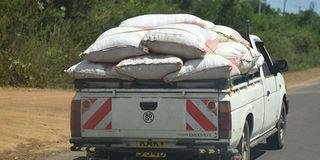Don’t yield to maize cartels, Mr Munya

Maize being ferried on the Moiben-Eldoret road in Uasin Gishu County on April 8, 2020. PHOTO | JARED NYATAYA | NATION MEDIA GROUP
What you need to know:
- It is important to sift through all the facts and figures carefully and make a judgement call on what quantities of maize we need.
- One thing Mr Munya has got to be firm about is not giving in to the vocal and powerful North Rift maize lobby.
Kenya will soon have a shortfall of its staple food — white maize — which will last until the next crop is harvested from September onwards.
Transatlantic imports of maize will need to start coming sooner rather than later to fill that gap. Cross-border imports from Uganda and Tanzania, if allowed, could ease, but not make up the shortfall.
The Covid-19 pandemic has made transportation longer and more cumbersome and will lengthen the lead time for imported supplies
Agriculture Cabinet Secretary Peter Munya has formally acknowledged that maize imports will be needed, but whether he has got his sums right and accepted the full urgency of the situation is an open question.
To his credit though, he has acknowledged the problem, albeit belatedly, which is an improvement on his predecessors.
COVID-19
Kenya often has structural deficits in maize production. These are frequently made up with informal imports from Uganda and Tanzania and at times transatlantic imports from surplus producers such as Mexico.
Kenya imports the majority of its wheat and a significant amount of its sugar needs and so is adept at the relevant food import procedures.
What makes it more complicated this time around is that the Covid-19 pandemic has resulted in the lead time for food imports being extended due to the 14 day quarantine requirement.
An additional negative factor are the ongoing locust invasions, which have decimated a number of crops around the country and made the food security situation more precarious.
How much these factors will impact negatively on Kenya’s food security situation remain to be seen, but it is essential, indeed critical, to err on the side of caution and plan for some serious shortfalls.
PLAN FOR SHORTFALLS
It is, therefore, important to sift through all the facts and figures carefully and make a judgement call on what quantities of maize we need, when we need them and for how long.
The estimates of how much stock we have vary between one and two months. Given the extended lead time of importing, we would need to start the process as soon as possible.
Mr Munya has said the government will authorise the importation of two million bags each of white and yellow maize.
The latter provision is a sensible one as this will go for animal feed thus releasing stocks of white maize for human consumption.
But Mr Munya’s planned importation is a mere drop in the ocean. Kenyans consume three million bags a month and, assuming we have enough until early next month, Mr Munya’s two million bags will only last us until June at the latest, and that is if it gets here in time.
AFFORDABLE FOOD
Moving forward, we will need to import three million bags of white maize each and every month until the start of the next harvest.
Also we should factor in the importation of yellow maize for animal feed so that some of the more expensive white maize is not diverted to animal feed needs.
In summary, we will need to bring in an extra 15 million bags more before September.
Considering the importation of maize has been dogged by inefficiency and scandal over the years, it will be interesting to see whether this time will be any different.
One thing Mr Munya has got to be firm about is not giving in to the vocal and powerful North Rift maize lobby.
At the end of the day, the government’s primary obligation is to ensure that the population have access to affordable basic food.
Mr Shaw is a public policy and economic analyst; [email protected]





